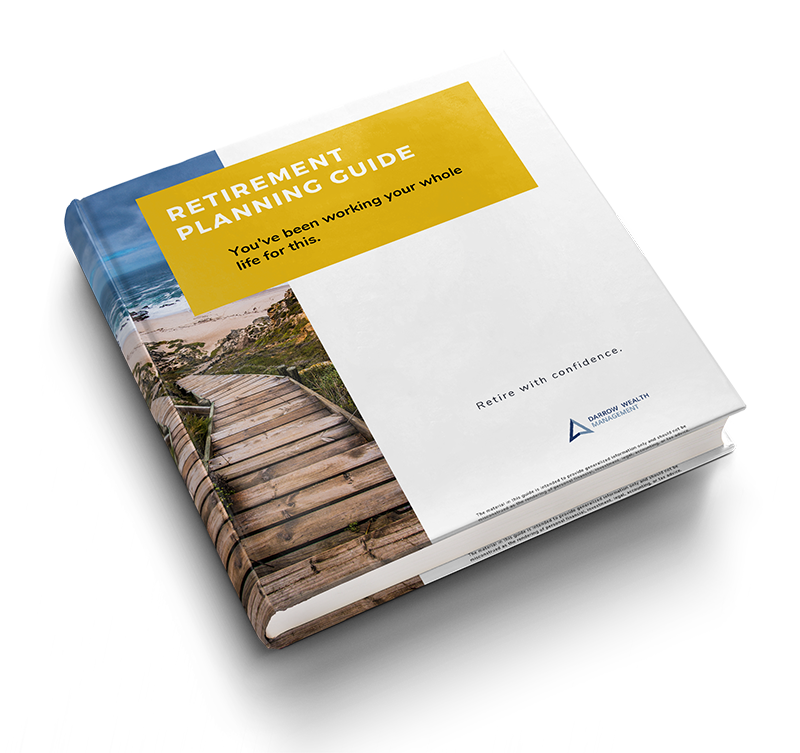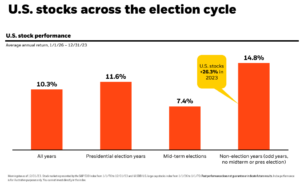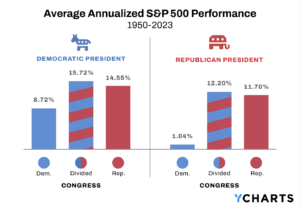Is maxing out your 401(k) enough? When saving for retirement, you’ll want to find out what level of income your current contributions could provide down the road. For some investors, saving diligently during their working years will be enough to provide the lifestyle they want in retirement. But for others, particularly high earners, only saving up to the annual IRS contribution limit may not be enough to meet spending needs in retirement.
Most retirement income projections don’t incorporate market moves
Basic compounding calculators (e.g. 6% annual return for 30 years) may be a good starting point, but they omit a key part of the retirement planning equation: markets go up and down. A Monte Carlo analysis takes market volatility and cash flows into account to get closer to determining a risk-adjusted withdrawal rate.
Financial planning is a complex and highly personalized process. It’s art and science. To help investors understand some of the factors they should consider, we’ve run a Monte Carlo analysis in specialized financial planning software for a hypothetical couple to illustrate how maxing out a 401(k) could translate into retirement income[1].
Important note: The information contained in this article is for illustrative purposes only and should not be misconstrued as the rendering of personalized recommendations, financial or investment advice, nor is it intended to provide a sufficient basis on which to make any financial or investment decisions. If you have questions about your personal financial situation, consider speaking with a financial advisor.
Assumptions made in the hypothetical analysis:
- Married couple, both age 35
- Combined retirement savings through 2019 is $200,000
- Starting in 2020, both individuals max out their 401(k) contributions (increasing 1.7% annually)[2]
- At age 50, the couple begins making catch-up contributions on top of their regular 401(k) savings[3]
- The couple retires at age 65 with a life expectancy of age 90
- Analysis excludes state income tax and income from Social Security benefits
- Based on the risk preferences for the hypothetical couple, the asset allocation before retirement is an 85/15 diversified mix of stocks and bonds; in retirement this drops to 70/30. Annual return and standard deviation assumptions were based on Morningstar’s long-term capital market expectations for the asset classes used in the analysis
Results:
- Overall, the Monte Carlo analysis appeared to support a maximum annual after-tax income of $65,000 (in today’s dollars) for the fictional couple, increasing 3% per year to keep pace with inflation
- The analysis included 500 simulations with an annual deficit tolerance of -$10,000. If the deficit was greater than -$10,000 any year, that trial is considered a failure
- In the hypothetical analysis, we required at least 80% (or 400) of the trials to be successful. A trial is considered a success if the fictional couple met or exceeded their income needs for the year, or in the event of a deficit, it was not greater than -$10,000.
Is maxing out your 401(k) enough? Depends on how much income you need in retirement.
Depending on your lifestyle, $65,000 per year (plus Social Security) may be enough to support your ideal retirement. Forecasting expenses in retirement is difficult, and some investors over-estimate how much they’ll need to support themselves when they stop working.
However, individuals and couples with high incomes generally need more to maintain their lifestyle in retirement, especially if you don’t want to rely on Social Security.
If the contribution limit on your 401(k) isn’t enough to adequately fund your income goals, to help supplement retirement savings consider opening a brokerage account. A taxable investment account can help further a variety of goals, before or during retirement:
- Way to save after maxing out a retirement account—or sometimes instead of a retirement account
- Provide income for an early retirement or simply maintain their lifestyle in retirement
- Invest for pre-retirement goals like a home or college
- Create additional tax planning opportunities in retirement
- Invest extra cash flow or proceeds from selling a home or business
- Diversify after selling stock options or a concentrated stock holding
No magic numbers, folks
There’s no magic number of retirement savings you need to be able to stop working. How much you’ll need saved is driven by your spending, not your nest egg. For example, if there are two 50-year-old investors, and one needs $50,000 per year to support their lifestyle, and the other needs $100,000 per year, all else equal, who needs to save more?
Most investors think about how much they can save after all their expenses, so after the vacation, mortgage, and bills, there’s X left to save and/or spend. Instead, try paying yourself first. For example, after maxing out your 401(k), consider setting aside a flat dollar amount for retirement, college, etc. Then think about how much is left to spend.
Obviously, you don’t want to get behind on your mortgage because you’ve plowing money into your brokerage account. But it’s helpful to treat your financial goals as another non-discretionary ‘bill’ and automating.
Why saving diligently for years doesn’t get you more
You might be surprised that maxing out a 401(k) for 30 years doesn’t provide more in retirement income. There are several reasons for this:
- Historically, inflation increases faster than IRS contribution limits, meaning your income needs in retirement are growing faster than you can save for them with only a 401(k)
- The financial markets don’t just go up. Even though long-term trends are positive, corrections are healthy (albeit painful) to keep valuations in check
- Social Security is a key factor in many retirement plans, but benefits were excluded from this analysis
- Required minimum distributions require retirees to draw down their accounts whether they need the money or not
Expenses increase faster than your savings rate
In this hypothetical example, the fictional couple is saving $39,000 this year to provide income of $65,000 when they retire. Their savings rate increases 1.7% per year (in line with increases to the IRS limits), while their projected inflation-adjusted expenses in retirement are increasing almost twice that annually. This is why lifestyle inflation is so damaging to your finances.
The market doesn’t just go up
Financial markets don’t move in a linear fashion like most basic retirement calculators assume. While it can be helpful to assume a static return in preliminary retirement planning projections, when you’re looking to find a sustainable safe withdrawal rate that is likely to withstand different market conditions, it requires a more robust analysis. This is where the Monte Carlo analysis—or stress-test—comes in.
The average annualized price return for the S&P 500 is about 9% between 1980 – 2019. Yet, over 40 years, the index only produced a 9% return once during this time. The actual return is typically much higher or considerably lower. Basic compounded return calculators only assume your investments grow; ignoring the other half of the equation that produced the average.
Investors should understand how volatility can impact your investments. If you lost -20% one day, you’d need a +25% gain the next day to break even. This is why it typically takes three years for the market to recover after a bear market. These investment risks require more conservative assumptions when retirement planning, which generally reduce income assumptions.
Social Security benefits could double your expected income in retirement
It’s important to note that this analysis excludes Social Security benefits. In 2020, the maximum benefit an individual would receive if they retired at full retirement age is $36,132 or $45,480 if they waited until age 70. These figures could be doubled if both spouses were eligible on their own work record.
Especially for younger investors, it’s difficult to know what changes may be in store for Social Security benefits. While it’s unlikely that the program will disappear, it might be a good idea to consider focusing on your own savings rate, which you can control.
Required minimum distributions force you to take money out
Whether you need the money or not, you’ll need to start taking it out of retirement accounts at age 72. This forces retirees to recognize taxable income and sacrifice future years of tax-deferred growth. Even if you reinvest the money in a brokerage account, you’ll still have to pay regular income tax on withdrawals from pre-tax retirement accounts. This is one of the reasons investors often save for retirement in a diversified mix of taxable, tax-free Roth, and tax-deferred accounts.
You’re not just saving for retirement
This analysis focused exclusively on a savings rate while working and what level of income that might produce during retirement. But you have a life to support financially now, and that can get expensive too.
Buying a home, saving for college, traveling, taking care of family, or just paying the bills can all add up. Saving for multiple goals make it more difficult to double-down on just one. Some years, you may even need to divert money from retirement. And we can’t predict the future: if you’re laid off or approached with an early retirement buyout package, your plans will change.
Plans that don’t bend, break. Life never goes according to plan. But savings = flexibility. The more you’ve saved along the way, the easier it will be to deal with unexpected challenges as they arise—and they always do.
Other factors to consider when saving and investing for retirement
As previously mentioned, this hypothetical analysis is more robust than the typical do-it-yourself retirement projections. However, the analysis is still overly simplistic relative to the complexities in our financial lives which impact our financial plans. This is another reason why there aren’t many universal answers in financial planning and investing: everyone’s circumstances are different.
Here are some of the other very real factors to consider:
- Not everyone is married! The analysis was for a married couple, but we don’t all have a spouse or go into retirement with one. Being single or divorced doesn’t mean you only have half the expenses, either.
- Even when married, many households are saving for retirement for retirement on one income, which cuts retirement contribution limits in half while potentially leaving income needs in retirement unchanged. Having a primary breadwinner may also alter your Social Security strategy, too.
- The timing of expenses in retirement matters, not just the amount. Overspending in the beginning of retirement. can damage your financial plan more than you might think.
- You might not want to work until 65—or might not be able to. Retiring early is increasingly challenging as life expectancies increase.
- We can’t control everything. Will the 401(k) plan be around forever? What if you live longer? Will contribution limits keep increasing as they have in the past? What about changes to the tax code? What can you do to prepare your finances for another recession? There are always unknowns, but the more you’ve saved the better equipped you’ll be to change course.
- You likely have other assets, financial windfalls, and/or benefits at work which help boost your savings. A pension, employer 401(k) match, stock options after your employer goes public, or even an unexpected inheritance can change your financial picture dramatically.
Whether you’ve been maxing out your 401(k) since you were 25 or a doctor getting a late start, consider the benefits of a high savings rate relative to expenses and the power of compounded growth over time. If you’re unsure about your current strategy, waiting until you’re on the cusp of retirement to work with a financial advisor generally isn’t the best approach. After all, you can only spend a dollar once.
This article was written by Kristin McKenna, CFP® and originally appeared on Forbes.
Disclosure
The information contained in this article is for illustrative purposes only and should not be misconstrued as the rendering of personalized recommendations, financial or investment advice, nor is it intended to provide a sufficient basis on which to make any financial or investment decisions. If you have questions about your personal financial situation, consider speaking with a financial advisor.
[1] Hypothetical projections assume reinvestment of income, no transaction costs or investment expenses, and a 12% Federal marginal income tax rate.
[2] Over the last 10 years (between 2011 -2020), the average annual increase of the employee contribution limit for 401(k) plans was 1.7%
[3] Over the last 10 years, the average annual increase to the 401(k) catch-up contribution was also roughly 1.7%










